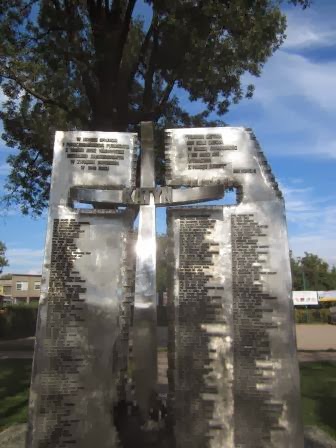In March 1940 the Russian NKVD (secret police) murdered 22,000 Polish Army officers and reservists in the Katyn Forest. Today war memorials in honor of those killed in the Katyn Forest can be found in most towns and villages.
 Stalin ordered the attack on Poland on September 17, 1939, less than three weeks after Hitler invaded Poland. (Or the Russian version – moved to liberate Russians under Polish domination.) Poles were caught off guard as they had retreated east away from Germany, and the result was disastrous. The Red Army conquered enough space over 13 million Poles were once again in Russian boundaries. At least 130,000 officers of the Polish army came under Soviet jurisdiction – but the numbers could be double that. Though some escaped quickly, it’s generally agreed that at least 125,000 were imprisoned by the NKVD (Russian equivalent to Nazi Gestapo) in a series of camps.
Stalin ordered the attack on Poland on September 17, 1939, less than three weeks after Hitler invaded Poland. (Or the Russian version – moved to liberate Russians under Polish domination.) Poles were caught off guard as they had retreated east away from Germany, and the result was disastrous. The Red Army conquered enough space over 13 million Poles were once again in Russian boundaries. At least 130,000 officers of the Polish army came under Soviet jurisdiction – but the numbers could be double that. Though some escaped quickly, it’s generally agreed that at least 125,000 were imprisoned by the NKVD (Russian equivalent to Nazi Gestapo) in a series of camps.The men were separated by officers, policeman, senior officers and educated elite. In March 1940 a decision was made regarding 14,700 officers and elite, as well as 11,000 other ‘spies’ – e.g. landowners and Polish reserve officers. There was a sham ‘hearing;’ Stalin and three others signed death warrants, and it took a month for executioners to complete the task of killing over 22,000 of them. The officers were buried in out of the way places. In 1943 the Germans discovered a mass grave in the Katyn Forest of over 4,000 Polish officers – many were shot with their hands behind their backs, and buried in their uniforms (and I think their identity papers as well.) Germans blamed the Russians, the Russians blamed the Germans, and Poles always blamed the Russians. In fact, for years all most people knew was that the Polish officers had disappeared without a trace. The Russians never admitted to the crime until 1990.
As if the Katyn Forest was not already a cursed place for Poles, incredible tragedy struck again in April 2010. A plane carrying 96 top officials of the Polish government, including the president and his wife was bound for Smolensk to commemorate the 70th anniversary. The plane crashed; all aboard died. Beyond the human tragedy – it wiped out the top tier of Polish civil service.
Note – Krakow was under German government, not Soviet, so the Katyn Forest is not really part of Henry’s story per se, but it’s part of the fabric and soul of all Poles. Texans have a saying ‘Remember the Alamo.’ I think for Poles it would be ‘Remember the Katyn Forest.’
Photo of monument to Katyn taken in Wadowice, Poland October 2013. The candle and plaque sit in front of the cross-shaped monument in the first picture. Surrounding the cross are the names of all the Polish Army officers from Wadowice who perished in the Katyn killings – notice the word ‘Katyn’ in the middle of the cross. I believe there are many such monuments in towns throughout Poland – no place went unscathed.
Sources – Gellately, Zamoyski,.

